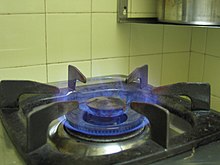Fuel gas
Fuel gas is combustible gas that is primarily or widely used as fuel . The best known fuel gas today is natural gas . Fuel gases, which are primarily used as fuel, are sometimes called " fuel gas ".
Fuel gas types
The German Association for Gas and Water divides fuel gases into the following gas families :
|
DVGW - gas family |
Fuel gases | Origin / Notes |
|---|---|---|
|
N (natural, petroleum and natural gases) |
Natural and petroleum gases | fossil fuel from natural deposits, mine gas . |
| hydrogen | i. d. Usually obtained by synthesis ; is gaining in importance as an energy store , as a CO 2 -neutral fuel, and as a low-emission fuel for cars in cities | |
| Natural gas | Bio / compogas (as digester gas from biogas plants or composting plants or as landfill gas or sewage gas ) is gaining in importance as a regenerative fuel | |
|
F (liquefied gases) |
Liquid gases (especially propane and butane ) | Refinery gases , by-products of petroleum refining |
|
S (town and long-distance gases) |
Town gases ( coal gases ) | Coal gases (such as coke oven gas / moon gas , blast furnace gas / blast furnace gas , mine gas , water gas / synthesis gas , generator gas , wood gas, etc.) were generated in larger quantities by gasification processes or were used in coal ( mining ) before natural gas was not yet widely available . and steel industry as by-products. These gases often contain significant amounts of toxic CO and are therefore undesirable. With the decline of the aforementioned branches of industry and because of the health hazard, they are increasingly losing importance and are no longer fed into public networks today. |
|
L ( air gases ) |
Air-gas mixtures | "Aerogen gas" (only historical meaning) |
properties
composition
Most fuel gases consist of the following main components in different compositions:
| Components | Combustible components Note: Each of these components is also individually a fuel gas. |
Non-flammable components |
|---|---|---|
|
Main components |
|
|
|
Minor components |
|
|
Physico-thermal properties
The most important characteristic value of a fuel gas is - as with any fuel - the calorific value or calorific value . In addition, a large number of other variables are very important for a fuel gas that hardly play a role with solid or liquid fuels: density , Wobbe index , dew point , explosion limits , etc.
application
Transportation and storage
Fuel gas is distributed on a large scale via pipelines and pipeline networks, so they are piped energy carriers . The public networks are under the control of the gas suppliers and the Federal Network Agency .
They are stored in gasometers or underground caverns . In smaller quantities, especially for special applications and for mobile use, liquefied fuel gas (especially LNG ) is used, which can be stored and transported in pressure tanks .
combustion
Combustion gases are usually burned in gas burners which, with a structurally predetermined mixture with air, enable low-residue combustion.
Harmful ingredients, especially hydrogen sulfide , are already removed by the supplier.
Under normal circumstances, the combustion gases produce fewer air pollutants and ash than solid or liquid fuels. This makes fuel gases particularly valuable fuels.
safety
Because of the considerable risk of explosion , special safety regulations apply when handling fuel gases. In Germany, these are primarily the relevant technical rules and the rules of the DVGW , in particular the technical rules for gas installation and the technical rules for liquid gas .


